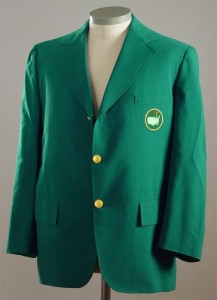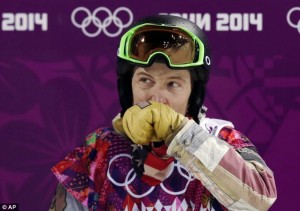April 12th, 2015 by Amy Bolger
 AUGUSTA, Ga. — The Masters green coat that came into vogue in the late 1930s has become what amounts to the world’s most recognizable reversible jacket. Augusta National Golf Club members wear theirs on the grounds to make themselves visible to tournament patrons seeking guidance on the course. And the reigning Masters champion wears it to make himself visible outside the club’s gates to anyone in search of a connection. AUGUSTA, Ga. — The Masters green coat that came into vogue in the late 1930s has become what amounts to the world’s most recognizable reversible jacket. Augusta National Golf Club members wear theirs on the grounds to make themselves visible to tournament patrons seeking guidance on the course. And the reigning Masters champion wears it to make himself visible outside the club’s gates to anyone in search of a connection.
The winner is allowed to remove the jacket, one of the most classic prizes in sports, from the Augusta National grounds only during the year of his reign. Gary Player said that after he won the 1961 Masters, he took the jacket home to South Africa, “hung it up with my honors blazer from other sports at school in a plastic bag,” and forgot about it.
The next year, Player lost to Arnold Palmer in a three-way playoff and returned home. Shortly thereafter, he received a call from Clifford Roberts, one of Augusta National’s founders, reminding him that he needed to return his jacket to the club.
Only one jacket is allowed to circulate in public in any given year, heightening its mystique.
“It’s very rare that it makes appearances anywhere,” said the 2013 champion Adam Scott, who treated his green jacket as his plus-one.
It was on his arm in his native Australia, in his homes in Switzerland and the Bahamas, and at every organized dinner or informal party to celebrate his becoming the first golfer from his country to enjoy the pleasure of the jacket’s company.
To the club members, the bright green garment, made of tropical-weight wool and polyester, with a rayon lining, an Augusta National logo patch on the left breast pocket and brass buttons, is a status symbol.
On Scott and the other players who have worn it over the decades, the jacket represents something more powerful. It is a conversation piece, a cover-up that causes people to display their joy and awe.
“It’s been mostly what anyone talks to me about in the last 12 months since the Masters,” Scott said, adding: “It always gets an incredible reaction if there are golfers in the room. If they are not golfers, they wonder why I’m wearing a very bright green jacket, I think.”
In airports, at cocktail parties and waist-deep in the Pacific surf, strangers have shared with Scott where they were last April when he defeated the Argentine Ángel Cabrera on the second playoff hole.
“People were just as excited to tell me where they were when I won and their story as I was talking about the Masters,” Scott said. He laughed. “So I got cut off a lot of times.”
Nick Faldo heard a story when he wore his green jacket on a talk show in Britain in 1989, after winning the first of his back-to-back titles. The other guest was the actor Sean Connery.
Faldo said: “The most amazing thing about Sean Connery, if I can tell the story he told me then, is when he was James Bond back in the early ’60s and everyone was inviting him to everything, to be a member of every club in the world, he got his invitation to be a member of Augusta National and threw it in the bin. He didn’t know what it was.
The jacket’s hue, called Masters green, proved ideal for color television, which captured it, and the tournament, in all its radiance. If the jackets could talk, oh, the tales they could tell. The 2011 champion Charl Schwartzel left his in the back seat of a car driven by a tournament volunteer.
“The car drove off, but the guy was honest enough to bring it back,” Schwartzel said, adding: “It could have been worse. If you left it in a taxi, then they would have gone with the jacket.”
Phil Mickelson, the winner of three Masters jackets, has worn one on the floor of the New York Stock Exchange and in the drive-through of a Krispy Kreme doughnut shop, where he was photographed by the store manager.
“I think it’s such a cool thing to be able to travel around with it,” Mickelson said, adding, “That’s a really special thing that the club allows the champion to do.”
Mike Weir, who in 2003 became the first Masters winner from Canada, wore his jacket to drop the puck at a Toronto Maple Leafs playoff game against Philadelphia and got chills when the players responded by tapping their sticks on the ice.
Like Cinderella’s glass slipper, the green jacket has a transformative effect on those able to slip into one. The former N.F.L. receiver Andre Reed and the retired baseball slugger Ken Griffey Jr., who never won their professional sports’ ultimate prizes, took turns trying on Mark O’Meara’s green jacket at a party in his honor after his 1998 victory.
“Their eyes lit up,” O’Meara said.
Trevor Immelman, who won 10 years after O’Meara, was in an airport in Japan when a group of businessmen saw the green jacket draped over his arm and started crying.
“I think the awe is the same as when I’ve touched an Olympic gold medal or Stanley Cup,” Immelman said. “It’s the pinnacle of sport, really.”
Immelman’s countryman, Player, who won three Masters titles from 1961 to 1978, said he had never worn his jacket in public. “Not even at my dinner table with my 13 grandchildren,” he said.
Jack Nicklaus, a six-time winner, said, “I’ve never taken it off the club grounds.”
Fuzzy Zoeller, who won in 1979, said he had worn his jacket during a parade in his honor in his hometown, New Albany, Ind. “And that was about it,” he said.
Zoeller is reunited with his jacket every year when he returns to Augusta National for the Champions Dinner and the par-3 contest. “There is something magical,” he said, about wearing it on the grounds during the tournament. “People want to walk up and feel it, touch it.”
During his yearlong reign, Schwartzel, like Scott, squired his green jacket all over the world.
“Any opportunity I had to wear it, I would wear it,” he said. “Any functions, I would rather wear the green jacket than a suit. It went down a lot better.”
Immelman said, “I think the last few years, the champions have done a great job of showing it off a little more.”
He added, “If I had the chance to wear it again, I’d do more with it.”
Scott never took the jacket to some spots he treasures in Australia, one reason he is eager to keep it another year.
“There were a lot more places to wear it than I had nights up my sleeve,” said Scott, who is six shots off the pace after 54 holes. “The only way to deal with that is winning again.”
Congrats, Jordan Spieth!

January 7th, 2015 by Amy Bolger
 Check Refund Status Check Refund Status
You can check the status of your federal income tax refund using IRS2Go. Simply enter your Social Security number, which will be masked and encrypted for security purposes, then select your filing status and enter the amount of your anticipated refund from your 2013 tax return. A status tracker has been added so you can see where your tax return is in the process. If you filed your return electronically, you can check your refund status within a 24 hours after we receive your return. If you file a paper tax return, you will need to wait about four weeks to check your refund status because it takes longer to process a paper return.
Tax Records
You can request your tax return or account transcript using your smartphone. IRS2Go allows you to request this information, which will be mailed to you within several business days.
Free Tax Prep Providers
The IRS Volunteer Income Tax Assistance (VITA) and the Tax Counseling for the Elderly (TCE) Programs offer free tax help for taxpayers who qualify. You can use this brand new tool to help you find a VITA site right near your home. You simply enter your zip code and select a mileage range. To make it even more convenient if you click on the directions button within the results the maps application on your device will load with the address, making it easy to navigate to your desired location.
Stay Connected
You can interact with the IRS by following us on Twitter, watching helpful videos on YouTube, sign up for email updates, or contact us.
Download the IRS2Go App
If you have an Apple iPhone or iTouch, you can download the free IRS2Go app by visiting the iTunes app store. If you have an Android device, you can visit Google Play to download the free IRS2Go app.

December 26th, 2014 by Amy Bolger
 On December 19, 2014, President Obama signed into law The Tax Increase Prevention Act of 2014 (HR5771), which which temporarily extends over 50 expired incentives for individuals, businesses and energy through 2014. The law also creates Achieving a Better Life Experience (ABLE) accounts set up for the benefit of persons with disabilities. Extenders included in the legislation are the state and local sales tax deduction, IRA distributions to charity, and the above-the-line deduction for higher education. On December 19, 2014, President Obama signed into law The Tax Increase Prevention Act of 2014 (HR5771), which which temporarily extends over 50 expired incentives for individuals, businesses and energy through 2014. The law also creates Achieving a Better Life Experience (ABLE) accounts set up for the benefit of persons with disabilities. Extenders included in the legislation are the state and local sales tax deduction, IRA distributions to charity, and the above-the-line deduction for higher education.
Key provisions in the bill particularly impacting construction and real estate businesses include the extension of 50% bonus depreciation and qualified leasehold improvements for the 2014 tax year. Under HR 5771, qualified leasehold improvement property will continue to be eligible for 50% bonus depreciation. This property is defined in IRC 168(k)(3) as new improvements to an interior portion of a building that qualifies as nonresidential real property. In addition, this treatment is available as long as the improvements are made by the lessor more than three years after the date the building was placed in service.
Notable exceptions to qualified leasehold improvement treatment include: elevators, escalators, structural components benefiting a common area, or the internal structural framework of the building. For more information or to take advantage of the new legislation, please contact Eric L. Bach & Associates for a free consultation.

August 11th, 2014 by Amy Bolger
 Following the recession, retailers are growing once again and, increasingly, moving online. In the first quarter of 2014, retail sales were 2.4% higher than the same time the year before, largely helped by a 15% jump in e-commerce sales. Online retail is increasingly accounting for more and more of America’s shopping. Following the recession, retailers are growing once again and, increasingly, moving online. In the first quarter of 2014, retail sales were 2.4% higher than the same time the year before, largely helped by a 15% jump in e-commerce sales. Online retail is increasingly accounting for more and more of America’s shopping.
Yet not all retailers have adapted to a market where many Americans have less disposable income, and are increasingly choosing to shop online. Other companies, in turn, have become enormously successful by embracing these changes. Based on figures from the National Retail Federation’s (NRF) STORES magazine, compiled by Kantar Retail, 24/7 Wall St. identified America’s Fastest-Growing Retailers.
In 2013, Amazon.com’s U.S. sales rose by 27%, the most of any retailer. For some retailers, such as Tractor Supply Co., part of its continued growth comes from the fact that they sell products Amazon.com simply cannot, such as farm equipment and livestock.
Many other retailers have also moved online, embracing a more-targeted approach in order to set themselves apart from the competition. Bryan Gildenberg, chief knowledge officer at Kantar Retail, told 24/7 Wall St. that this kind of personalized approach, “makes buying much more enjoyable and finding what you want much quicker.”
Some retailers have benefited from the financial struggles facing many Americans. This includes Family Dollar, which targets low income shoppers and had 11% growth in sales in 2013. Others, such as Sherwin Williams, have benefited from more positive developments in the economy. An improving housing market helped the company’s sales rise by 18% last year.
And while many growing retailers are deeply impacted by changes in the economy, others are benefiting from evolving customer tastes. Both Whole Foods and Apple are among the fastest-growing retailers in America, and both have very strong brands aligned with changing consumer spending. Whole Foods’ commitment to organic food and Apple’s exceptional mobile product quality both resonate strongly with customers, who are often willing to pay more for these items.
While many of the fastest-growing retailers have different customers and products, they also have a great deal in common. Gildenberg noted that many retailers aimed “most of [their] energy at the middle of the market.” However, he added that, recently, growth has generally been stronger among companies that target a specific segment of the population.
For example, he noted that Whole Foods and Family Dollar are much more similar than they might look at first glance. “They both target segments of the population that general mass retail, for whatever reason, doesn’t serve as well.”
The addition of new stores can also play an important role in driving sales growth. Excluding Amazon, which is exclusively online, all but one of the fastest-growing retailers increased their U.S. store count in 2013. The one retailer that did not do so, AT&T, has heavily invested in new store designs and has opened or renovated a number of locations. Gildenberg noted that store growth is currently quite strong among more specialized retailers with unique store concepts.
To identify America’s 10 fastest-growing retailers, 24/7 Wall St. reviewed STORES’ Top 100 Retailers report. The report is based on Kantar Retail’s estimates for companies’ retail-only sales, and includes the 100 largest companies by this measure, as well as their estimated number of stores. The companies on our list had the largest percentage gains in U.S. retail sales between 2012 and 2013. Sales figures listed do not include third-party sales. We also excluded Albertson’s and Ascena Retail Group from our list. These companies had retail revenue gains that were largely driven by transformative mergers and acquisitions.

July 11th, 2014 by Amy Bolger
Iraq has warned the UN that Sunni militants have seized nuclear materials used for scientific research at a university in the city of Mosul. In a letter seen by Reuters, Iraq’s envoy to the UN said nearly 40kg (88lb) of uranium compounds were seized. The letter appealed for international help to “stave off the threat of their use by terrorists in Iraq or abroad”.
But the UN atomic agency IAEA said the material was “low grade” and did not pose a significant security risk. US officials have also reportedly played down the threat, saying the materials were not believed to be enriched uranium. They added that it would be difficult for the rebels to use the materials to make weapons.
“Terrorist groups have seized control of nuclear material at the sites that came out of the control of the state,” Ambassador Mohamed Ali Alhakim said in the letter. “These nuclear materials, despite the limited amounts mentioned, can enable terrorist groups, with the availability of the required expertise, to use it separately or in combination with other materials in its terrorist acts,” he added.
However, International Atomic Energy Agency (IAEA) spokesperson Gill Tudor said on Thursday it “would not present a significant safety, security or nuclear proliferation risk”. But she said that “any loss of regulatory control over nuclear and other radioactive materials is a cause for concern”.
Mosul, some 400km (250 miles) north-west of Baghdad, was last month seized by Isis-led (Islamic State in Iraq and the Levant) insurgents.
The letter comes a day after Iraqi officials confirmed that the rebels were in control of a disused chemical weapons factory. Iraq said the Muthanna complex, north-west of the capital Baghdad, housed remnants of rockets filled with sarin and other deadly nerve agents. The UN and US have said the munitions are degraded and the rebels will be unable to make usable chemical arms from them.
Meanwhile, tensions are building between the central Iraqi authorities and the autonomous Kurdistan regional government, one day after Iraqi Prime Minister Nouri al-Maliki said Isis militants were being harboured in the Kurdish city of Irbil. A spokesman for Iraqi Kurdish leader Massoud Barzani said that Mr Maliki had become hysterical and urged him to step down. He said: “You have destroyed the country and someone who has destroyed the country cannot save the country from crises.” Kurdish ministers have also said they would not attend cabinet meetings until further notice in protest at Mr Maliki’s comments.
In recent weeks, Isis insurgents have seized huge swathes of north-western Iraq. Kurdish troops moved into areas abandoned by the Iraqi forces during the Isis onslaught, including the oil-rich region of Kirkuk. The UN has said at least 2,417 Iraqis, including 1,531 civilians, were killed in “acts of violence and terrorism” in June. More than a million people have fled their homes as a result of the fighting.

February 20th, 2014 by Amy Bolger
 This one was for Sarah. Her braid whipping in the chilly mountain air, Maddie Bowman of the US soared to the first gold medal in women’s Olympic half pipe skiing on Thursday, edging out Marie Martinod, of France, in the final. This would be a night to remember as they were paying tribute to their friend, Canadian freestyle skiing icon Sarah Burke. This one was for Sarah. Her braid whipping in the chilly mountain air, Maddie Bowman of the US soared to the first gold medal in women’s Olympic half pipe skiing on Thursday, edging out Marie Martinod, of France, in the final. This would be a night to remember as they were paying tribute to their friend, Canadian freestyle skiing icon Sarah Burke.
Burke, a leading advocate of adding several events — including half-pipe — to the Olympic program, died following a training accident in 2012. Her parents, Gordon Burke and Jan Phelan, watched as Bowman made history.
“It was Sarah’s dream to be here,” Phelan said. “So, it’s here. The half-pipe is opening for the women and I miss her like crazy.”
The athletes Burke championed tried to rise to the occasion, Bowman in particular.
“Sarah has inspired us on snow or off snow,” Bowman said. “I think she would have been very proud of how all the girls rode tonight. … I hope I and all the other girls made her proud. We wouldn’t have been here without her.”
Bowman showed some of Burke’s tenaciousness in the finals.
The 20-year-old from South Lake Tahoe, Calif., was just third in qualifying but found a rhythm in the medal round after overcoming some jitters that she joked made her want to “barf.”
Stringing along a dizzying series of spins and grabs, Bowman performed the two highest-scoring runs of the night.
Bowman’s first finals run, an 85.80, put pressure on Martinod, who led qualifying. Bowman’s second trip through the half-pipe was even better. She clasped the side of her helmet in disbelief then sat and waited to see if Martinod or American teammate Brita Sigourney could top her.
Nope.
Sigourney, who washed out in her first finals run, appeared ready to threaten Bowman before her backside skimmed the snow with only one jump off the 22-foot half-pipe left to complete her run.
That left Martinod, who retired in 2007 but returned to the sport in 2012 at the urging of Burke. The 29-year-old Frenchwoman was one of the older performers in the 23-skier field and her introduction included a series of outtakes with her 4-year-old daughter Melirose.
“She’s my everything,” Martinod said. “I keep training and charging and doing what I love because I want her to see how great it is to achieve some goals and be able to reach the point I wanted to be.”
It’s a spot Martinod would not have reached if not pushed by Burke, who casually suggested to Martinod three years ago that it was time to come back. Burke was convinced the half-pipe would be in the Olympics. Martinod was not sure she was up for the challenge after such a long layoff.
“I said, ‘Sarah, I love you, but it’s not possible,”’ Martinod said. “It’s too long (a) time. I quit skiing.”
It didn’t look like it in the final. Her 85.40 earned silver and gave her a chance for her to say “goodbye” to Burke. Martinod painted snowflakes on her fingernails in tribute then stood on the podium alongside her daughter in triumph.
“I feel very proud of these women,” Martinod said.
There were several hard crashes during qualifying, the worst coming when Anais Caradeux slammed into the ice during her second run. The 23-year-old Frenchwoman lay motionless for several seconds before being tended to by medics.
Caradeux sustained lacerations on her face but managed to ski down the half-pipe to the medical tent. She qualified ninth but didn’t compete in the finals. Caradeux said afterward she blacked out for 10-to-15 seconds and sustained some short-term memory loss.
She was hardly alone on a sometimes bruising night. Sigourney took a rough fall during her first finals run, with Bowman sprinting up the half-pipe to help her up. She recovered in time to take a second trip down the slope but it wasn’t nearly good enough.
Sigourney blinked back tears of disappointment, though they were soon cast aside during an event that served as a celebration of Burke’s legacy.
“A lot of girls were really pushing themselves,” said Rosalind Groenewoud of Canada, who finished seventh. “I wish (Sarah) could have won tonight if it wasn’t me.”
Bowman’s gold was the sixth for the U.S. at Rosa Khutor Extreme Park. She was joined by teammate David Wise — who won gold in the men’s competition Tuesday — atop the medal stand, though Bowman understood the night was about more than just national pride.
“This is first time a lot of people in this world saw what we do and why we love it,” she said.

February 20th, 2014 by Amy Bolger
 Marie-Philip Poulin scored twice for the second straight Olympic gold medal game and Canada beat the United States 3-2 in overtime on Thursday for its fourth consecutive title. Marie-Philip Poulin scored twice for the second straight Olympic gold medal game and Canada beat the United States 3-2 in overtime on Thursday for its fourth consecutive title.
Canada trailed 2-0 before Brianne Jenner and Poulin scored in the final 3:26 of regulation, and Poulin had the game-winner with a power play goal at 8:10 of overtime.
Shannon Szabados made 27 saves for Canada, which has won 20 straight in the Winter Games since the Nagano final in 1998. That was the only gold medal for the United States, which has lost in the Olympic final to Canada three times since then.
Jesse Vetter made 28 saves for the Americans. Meghan Duggan and Alex Carpenter scored for the U.S.
Switzerland beat Sweden for the bronze medal earlier Thursday.
Vetter, the loser in the Vancouver final, had a shutout until Jenner’s seemingly harmless shot deflected off a defender’s knee and into the net. With the goalie pulled for an extra skater, U.S. forward Kelli Stack sent the puck the length of the ice before it clanged off the post and landed harmlessly in front of the goal.
It was still a one-goal game, but not for long.
With Szabados still off, Poulin scored just 54.6 seconds before the end of regulation.
After six tense minutes of overtime, the U.S. picked up a power play when Catherine Ward was sent off for cross-checking. But five seconds later, Jocelyne Lamoureux was called for slashing for swiping at the goalie’s pads after a save. And during a bad player change by the Americans, five-time Olympian Hayley Wickenheiser got free on a breakaway before she was bumped from behind by Hilary Knight and sent sprawling.
It could have been called a penalty shot. It could have been no call.
But Knight was sent to the penalty box for cross-checking. With the 4-on-3 advantage, the Canadians worked the puck around and over to Poulin, who knocked it into the open net and set off the celebration on the bench and among the Maple Leaf-waving fans.

February 17th, 2014 by Amy Bolger
For the fifth time in Olympic history, the world’s best female hockey players will face off for a shot at gold at the 2014 Winter Games in Sochi, Russia.
The strong growth of women’s hockey saw the sport approved for Olympic inclusion in 1992, with a debut at the Nagano games in 1998. Team USA triumphed at that inaugural event, but the powerhouse Canadians have since won three straight golds in 2002, 2006 and 2010.
The continued dominance of the two North American squads over the rest of the field has led to a format change that was first introduced at the 2012 IIHF World Championship. The change in group structure has proven successful at creating a better competitive balance in the early rounds and lessening the dominating blowouts inflicted by the U.S. and Canadian sides.
If you’re familiar with men’s hockey, you won’t see a lot of difference in the women’s game—except for the ponytails hanging out from the bottoms of players’ helmets. Body-checking is illegal in women’s hockey, but there’s still a strong physical component to the game. Female players are just as adept as the men at using their bodies and sticks to challenge their opponents—they’re just a little sneakier.
Women’s hockey is one of the first events to kick off at this year’s Games. The preliminary round gets underway on Feb. 8 at Shayba Arena, and the gold medals will be awarded on Feb. 20 at the Bolshoy Ice Dome.

February 12th, 2014 by Amy Bolger
 Shaun White lost to a kid they call “I-Pod,” and now, he may never hear the end of it. Shaun White lost to a kid they call “I-Pod,” and now, he may never hear the end of it.
How big of an Olympic shocker was this? White, the best snowboarder of his era and one of the best-known and best-marketed athletes at the Sochi Games, didn’t even win a medal. He finished fourth.
The 27-year-old American, who opted out of the Olympic slopestyle debut and put all his chips in the halfpipe, where he hoped to win a third straight gold, got knocked off by Iouri Podladtchikov, the Russian-born inventor of the “Yolo,” the trick that White could not master.
“I’m disappointed,” White said. “I hate the fact I nailed it in practice, but it happens. It’s hard to be consistent.”
The Japanese tandem of 15-year-old Ayumu Hirano and 18-year-old Taku Hiraoka won silver and bronze, respectively, and the Americans were shut out in the halfpipe for the first time since the sport was introduced to the Olympics in 1998.
Podladtchikov, who lives in and competes for Switzerland, landed the trick successfully at an event in Europe last season, but hadn’t done it since.
“I’m about to faint. I haven’t seen the gold yet,” said Podladtchikov, who gets his gold Wednesday. “That’s why I don’t believe it.”
White watched the replay of I-Pod’s trick last March on his computer and went to work trying to match it.
He landed it twice in qualifying events and was listed as the heavy favorite to become the seventh person to win three straight gold medals in an individual event at the Winter Games.
White had come to Russia hoping to win two gold medals, but when he pulled out of the Olympics’ inaugural slopestyle contest, saying he didn’t want to risk injury for his historic quest on the halfpipe, the stakes were set.
It unraveled early.
On White’s first of two runs in the final, his attempt at the Yolo ended with a fall that left him sliding down the halfpipe on his backside. Even though his chance at putting up a winning score was over, he tried to finish the run with another of his double-cork tricks. White wasn’t close — his board slammed on the lip of the pipe, followed by an awkward fall onto his rear.
I-Pod scored an 86.5 in his first run — clearly in medal contention — and then won it on his second attempt. The Yolo includes a total of 1440 degrees of spin — two head-over-heels flips and two 360-degree turns. Four years ago, it was unthinkable, but not anymore. He landed it, and even though he threw only five tricks when most riders were trying six in a supersized, super-slushy halfpipe, the judges liked what they saw.
As did I-Pod, who spiked his snowboard into the snow like a football and threw his goggles into the crowd.
“He’s incredible,” American Danny Davis, the 10th-place finisher, said of Podladtchikov. “That run on that halfpipe. Wow.”
I-Pod struggled in the qualifying round earlier Tuesday, forcing him into a semifinal round while White and the five other top scorers went directly to the final. The extra runs seemed to help, as did the cold night air that seemed to improve the condition of the halfpipe, which competitors had been complaining about all week.
I-Pod scored 87.50 on his first semifinal run, clearing his way to the final. His 94.75 in the second final run put huge pressure on White, whose final runs at the past two Olympics have been nothing more than pressure-free victory rides.
White stood at the top of the halfpipe, high-fived and bumped knuckles with his coach, clapped his hands and away he went.
The first two jumps were flawless — higher than anyone and landed more solidly.
Then, the Yolo. Tucking his hands together to generate torque, then waving one like a cowboy riding a bucking bronc, the form looked good during his three seconds in the air.
But on the landing, he skittered down the pipe and lost speed, which meant he lost height on the next jump, as well.
The landing on his last double cork was less than perfect, too — his knees buckled and nearly touched the snow. Across the finish line, White raised one finger in the air and raised his hands in victory. Yes, sometimes judges reward athletes for what they’ve done, not what they just did.
Not this time. White’s fourth-place score, a 90.25, came up, and he broke into a big smile. He gave Podladtchikov a big hug and, in a fatherly gesture, mussed his hair.
“I saw videos of Shaun doing it really well,” Podladtchikov said. “I got bummed, said, ‘Damn, that’s my trick and he’s doing it better than me.’ Today, I guess I was doing it a little better.”

February 9th, 2014 by Amy Bolger
 NBC’s Bob Costas has anchored the network’s Olympics coverage for several decades, to the point where many American viewers of the event consider him a feature of the competition along with those five (or sometimes four) iconic rings. However, as Costas struggles with a very apparent eye infection during the Sochi Games, he’s not quite the same presence in the studio. NBC’s Bob Costas has anchored the network’s Olympics coverage for several decades, to the point where many American viewers of the event consider him a feature of the competition along with those five (or sometimes four) iconic rings. However, as Costas struggles with a very apparent eye infection during the Sochi Games, he’s not quite the same presence in the studio.
On Thursday, Costas welcomed viewers to NBC’s opening night of Sochi coverage by drawing attention to his very, very red left eye. His infection quickly became the talk of pre-Opening Ceremony coverage, although the hope was that things would clear up relatively soon.
When Costas opened up NBC’s Monday night primetime coverage, it immediately became clear that no such thing has occurred. In fact, Costas looks quite a bit worse, with the infection now glaringly evident in both eyes.
Unlike Thursday, Costas did not immediately reference his condition on air. It appears that he’d prefer to focus on the Olympic action, even if his eyes are sure to remain a topic of conversation for as long as they continue to look this way.
Despite the sorry state of Costas’ eyes, chances are he’s not in serious medical danger. Typical recovery times for pinkeye — if that’s indeed what he has — run from a couple days to two weeks. Given his status at the network and the importance of the Sochi Olympics to NBC’s ratings and bottom line, it figures that Costas will continue to anchor coverage for as long as he’s medically able. He essentially owns Olympic coverage at NBC, and it would take a lot to keep him out of the studio.
However, it’s worth considering whether continued problems for Costas and his eyes will eventually negate the positives of having him in studio. Costas can be a divisive figure, but the mere fact that he has anchored Olympics coverage for so long provides measures of continuity and familiarity despite viewers often not knowing anything about Olympic athletes ahead of their events. But this Costas does not look like the anchor we know. With this infection, he only adds to the widespread, maybe unfair impression that the Sochi Games are a bizarre, dystopian entity. It’s all a little disorienting and confusing. Presumably, that’s not what NBC wants to communicate to viewers.

|
|
 AUGUSTA, Ga. — The Masters green coat that came into vogue in the late 1930s has become what amounts to the world’s most recognizable reversible jacket. Augusta National Golf Club members wear theirs on the grounds to make themselves visible to tournament patrons seeking guidance on the course. And the reigning Masters champion wears it to make himself visible outside the club’s gates to anyone in search of a connection.
AUGUSTA, Ga. — The Masters green coat that came into vogue in the late 1930s has become what amounts to the world’s most recognizable reversible jacket. Augusta National Golf Club members wear theirs on the grounds to make themselves visible to tournament patrons seeking guidance on the course. And the reigning Masters champion wears it to make himself visible outside the club’s gates to anyone in search of a connection.






